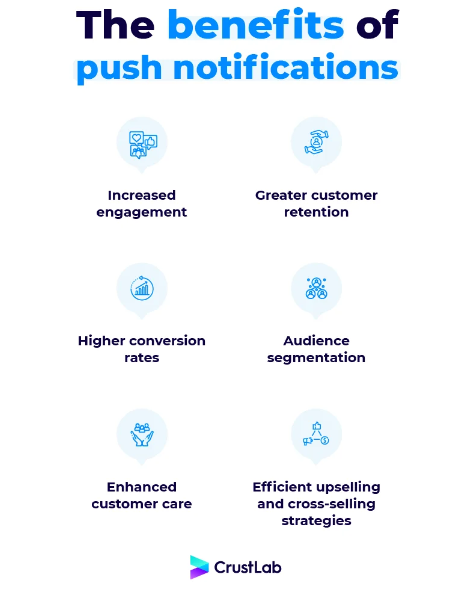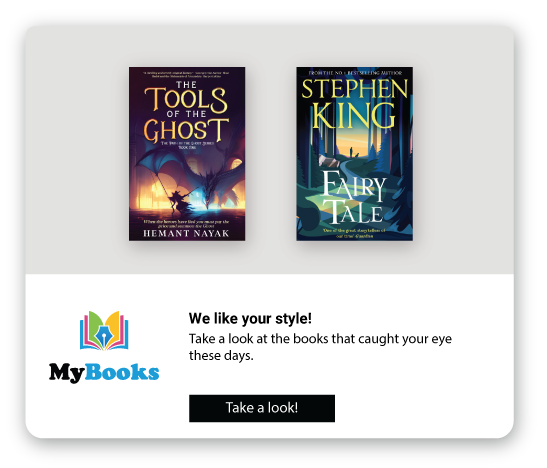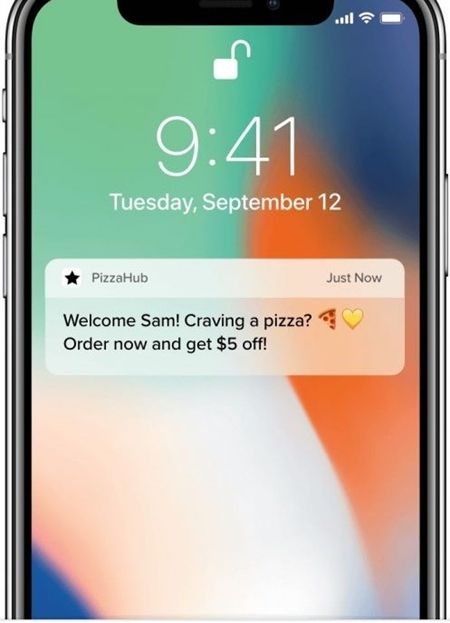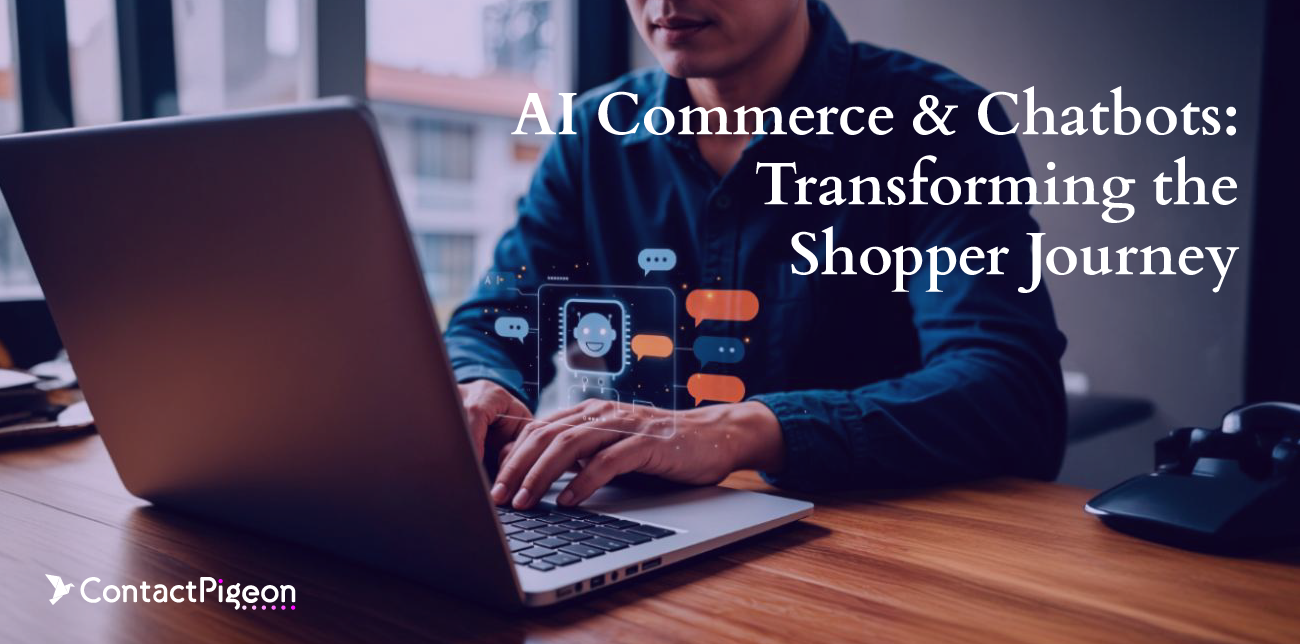In the omnichannel customer engagement mix, personalized push notifications have emerged as indispensable tools for addressing customers and driving conversions. Personalization revolutionizes the way retailers interact with their audience, with 80% of customers deeming it appropriate for brands to collect historical data to improve their services. Customizing messages based on user behavior, preferences, and demographics transforms generic alerts into compelling invitations, offering customers relevant content at the right time through their favorite devices. By leveraging data analytics and segmentation strategies, retailers can achieve push notification personalization that captures attention and inspires action.
The importance of implementing retail push notification best practices for targeted and tailor-made experiences cannot be overstated. It transcends the one-size-fits-all approach, fostering meaningful connections between brands and consumers. As such, retailers can provide real-time updates on promotions, product recommendations, and exclusive offers, enriching the shopping experience and turning around lost chances for conversions.
By delivering relevant content directly to consumers’ devices, retailers can increase engagement, boost customer retention, and drive sales. Thus, in this blog post, we’ll delve into the best practices for implementing personalized push notifications in the retail and eCommerce industry. From segmentation strategies to message optimization techniques, we’ll explore actionable insights to help retailers harness the power of personalization and unlock new avenues of success.
Benefits of automated push notification personalization

Automated push notification personalization offers several benefits, especially concerning GDPR compliance and the increased reach and brand awareness resulting from targeted device engagement:
Building trust and mitigating risk: why push notifications can be GDPR-friendly
Automated push notifications ensure compliance with GDPR since users have to opt-in to receiving promotional push campaigns beforehand. This failsafe enables retailers to securely manage user data, obtain explicit consent, and provide users with control over their preferences. By adhering to GDPR guidelines, retailers build trust with their audience, mitigate regulatory risks, and foster positive relationships based on transparency and data protection.
- Explicit User Consent is Key: A cornerstone of GDPR is explicit user consent. Push notifications inherently require user opt-in before receiving messages, aligning perfectly with this principle. Retailers should ensure their opt-in process is clear, concise, and easily accessible, specifying the types of push notifications users can expect (e.g., promotional offers, abandoned cart reminders).
- Transparency Builds Trust: Transparency is another critical aspect of GDPR. Retailers should provide users with a clear understanding of the data collected through push notifications (typically limited to device identifiers and preferences) and how it’s used. A robust privacy policy outlining these details is essential.
- User Control Empowers Customers: Empowering users with control over their data is crucial for GDPR compliance. Retailers should provide an easy-to-use opt-out mechanism for push notifications, allowing users to unsubscribe at any time. This could be through the app settings, a dedicated unsubscribe link within notifications, or both.
By adhering to GDPR guidelines, retailers gain several advantages:
- Stronger Customer Relationships: Transparency and user control build trust, leading to more positive customer relationships. Customers who feel their data is respected are more likely to engage with a brand.
- Reduced Risk of Regulatory Fines: Non-compliance with GDPR can result in hefty fines. Following best practices for user consent and data management significantly reduces this risk.
- Improved Data Quality: GDPR encourages accurate and up-to-date data collection. This translates to higher engagement with push notifications as messages are targeted towards users who genuinely want to receive them.
Targeted device engagement and increased reach
Automated push notifications allow retailers to target devices, instead of emails or contacts, based on user preferences, behavior, and location. This targeted approach ensures that notifications are delivered to users who are most likely to engage with the content, resulting in higher open rates and click-through rates. By reaching users on their preferred devices, retailers can maximize the impact of their messaging, increase brand visibility, and drive meaningful interactions with their audience.
While email marketing remains a staple, research indicates push notifications boast significantly higher open rates (averaging 70% vs. 20%). This advantage stems from their targeted nature. Unlike emails, push notifications can be delivered to specific devices based on:
- User Preferences: Retailers can segment audiences based on user-declared interests within the app (e.g., preferred product categories).
- User Behavior: Past purchase history or in-app activity can inform targeted messaging (e.g., abandoned cart reminders or personalized product recommendations).
- Location Data (with consent): Timely, location-based offers (e.g., discounts at a nearby store) can significantly boost engagement.
This granular targeting ensures messages reach users most likely to be interested, leading to:
- Increased Click-Through Rates: A study found click-through rates for push notifications can be up to 10x higher than email marketing.
- Enhanced Brand Visibility: Regular, relevant notifications keep your brand top-of-mind for users, fostering brand loyalty.
- Meaningful Customer Interactions: Targeted messaging drives deeper engagement, leading to conversions and increased customer lifetime value.
Campaign optimization
An automated push notification strategy facilitates data-driven campaign optimization by analyzing user behavior, preferences, and interactions in real-time. Through sophisticated algorithms and machine learning techniques, retailers can continuously refine their push notification strategies, identifying trends, patterns, and opportunities for improvement. By leveraging actionable insights derived from data analysis, retailers can optimize campaign performance, maximize engagement, and drive conversions more effectively, ultimately achieving better ROI.
The true power of push notifications lies in their ability to be continuously optimized. Unlike static email campaigns, push notifications leverage real-time data analysis for ongoing improvement. McKinsey reports that data-driven marketing efforts can generate up to 80% more revenue.
Retailers can utilize sophisticated algorithms and machine learning to analyze:
- User Behavior: Factors like time spent in-app, most-viewed products, and purchase history all inform campaign optimization.
- Engagement Rates: Open rates, click-through rates, and conversion rates provide valuable insights into campaign effectiveness.
- User Preferences: Understanding user preferences through A/B testing of content, timing, and personalization allows for targeted messaging.
By analyzing this data, retailers can identify trends, patterns, and opportunities for improvement. This empowers them to:
- Personalize Notifications: Tailored messaging based on user data fosters deeper engagement.
- Optimize Timing: Delivering notifications when users are most receptive maximizes impact.
- Refine Content: A/B testing uncovers the most effective messaging strategies.
Advanced techniques in push notification personalization
Location-based push notifications

A location-based push notification strategy enables retailers to leverage the geographical data of their customers to deliver hyper-targeted messages. By utilizing location services on mobile devices, retailers can send notifications tailored to users’ proximity to specific stores or events. This personalized approach not only enhances the customer experience but also increases the likelihood of driving foot traffic and conversions by delivering relevant content at the right place and time.
- A clothing retailer can send a notification to customers in the vicinity of a new store opening, inviting them to visit and enjoy exclusive discounts.
- A museum could send notifications to its visitors, suggesting a trip to its gift shop with relevant books or gifts related to the exhibits.
- Similarly, a restaurant chain can send alerts to users nearby, enticing them with special offers during peak dining hours.
Engagement-based push notifications

Engagement-based push notifications are messages sent to users based on their past interactions and behavior within an app or website. These notifications are designed to re-engage users, encourage continued interaction, and drive specific actions such as completing a purchase, revisiting the app, or participating in a promotion.
Use cases of engagement-based push notifications include reminders for abandoned carts, personalized product recommendations based on browsing history, and notifications about limited-time offers or flash sales tailored to the user’s preferences and past behavior. Each of these examples aims to spark renewed interest and activity from users, ultimately enhancing their overall engagement with the brand or platform.
- A retail app sends a reminder notification to a user who added items to their cart but did not complete the purchase, encouraging them to finalize their transaction with a special discount code.
- A music streaming service sends a personalized playlist recommendation notification to a user based on their listening history and preferences, enticing them to discover new music and spend more time on the platform.
- A fitness app sends a notification congratulating a user on reaching a personal milestone, such as completing a certain number of workouts or achieving a fitness goal, to motivate them to continue their progress and engagement with the app.
Lifecycle-based push notifications

Lifecycle-based push notifications are messages triggered by specific stages or actions along the customer journey and the conversion funnel with a product or service. These notifications are tailored to address the user’s current status or needs, guiding them through the customer lifecycle and enhancing their overall experience.
Use cases of lifecycle-based push notifications include welcome messages for new users, onboarding tutorials to help users familiarize themselves with key features and renewal reminders for subscription-based services. These types of personalized push notifications are designed to deliver timely and relevant content based on where the user is in their journey, ultimately driving engagement, retention, and satisfaction.
- A financial app sends a welcome push notification to a new user, providing a brief overview of its features and guiding them on how to set up their account for optimal use.
- An eCommerce platform sends a series of onboarding push notifications to a new user, offering tips on how to navigate the website, search for products, and make purchases, ensuring a smooth and enjoyable shopping experience.
- A productivity app sends a reminder push notification to a user whose subscription is about to expire, prompting them to renew their membership and continue accessing premium features and benefits.

Creative personalized push notification campaign ideas and patterns for eCommerce retailers
General push notification patterns
- Time-Sensitive Deals: “Only 2 hours left! Get 20% off your next purchase.”
- Location-Based Offers: “Special deal just for shoppers in [City]! Click here.”
- Loyalty Rewards Notifications: “Thanks for being a loyal customer! Enjoy an exclusive 10% off.”
- Abandoned Cart Reminders: “Forgot something? Your cart is waiting with a special 5% discount.”
- New Arrivals Alerts: “Be the first to grab the latest [Product Category] now in stock!”
- Back-in-Stock Alerts: “[Product Name] is back! Order now before it sells out again.”
- Price Drop Alerts: “Good news! The price dropped for items you love. Check them out now.”
- Exclusive Member Offers: “Members only: Enjoy 30% off on selected items today!”
Seasonal push notification campaign patterns & examples
- Holiday Specials: “Start the holiday season with a special 25% off on us!”
- Summer/Winter Sales: “Stay cool with hot deals this summer. Up to 50% off!”
- Black Friday Teasers: “Sneak peek at our Black Friday deals – Save the date!”
Personalized push notification product recommendation patterns
- Based on Past Purchases: “Loved [Previous Purchase]? You might like these similar items.”
- Based on Browsing History: “Still thinking about [Product]? It’s just a click away.”
- Upsell Opportunities: “Complete your set! Buy [Related Product] with 10% off.”
Event-triggered push notification patterns
- Anniversary of First Purchase: “Happy Shop-iversary! Celebrate with a special offer just for you.”
- Birthday Discounts: “Happy Birthday! Enjoy this special treat on your special day.”
- After First Purchase: “Thanks for your first order! Use this code for 10% off next time.”
Interactive push notification campaigns
- Polls and Surveys: “Tell us your favorite color and get a surprise discount!”
- Gamification Elements: “Spin the wheel and win a prize! Discounts, gifts, and more await!”
- Social Media Invites: “Join us on [Social Platform] and get an exclusive 15% off your next purchase.”
Re-engagement campaigns
- We Miss You: “We’ve missed you! Come back for an exclusive 20% off your next purchase.”
- Feedback Requests: “Help us improve! Give feedback on your last purchase and earn a 10% coupon.”
Using ContactPigeon’s CDP to improve push notification personalization strategy

- Centralized Customer Data: A CDP pulls together customer data from various sources (website, app, CRM, etc.) creating a unified 360-degree customer profile.
- Rich Segmentation: CDPs offer advanced segmentation capabilities, allowing retailers to target push notifications based on detailed demographics, behaviors, preferences, and purchase history.
- Real-time Data: A CDP updates customer data in real-time, enabling highly relevant and timely push notifications (e.g., back-in-stock alerts based on recent browsing).
- Journey Mapping: CDPs help visualize customer journeys, identifying ideal points for personalized push notifications to enhance the customer experience.
- Cross-Channel Coordination: A CDP integrates with push notification platforms, ensuring personalized messages align with a broader omnichannel marketing strategy.
- A/B Testing & Optimization: CDPs facilitate A/B testing of different push notification variants, helping identify which messaging and timing resonated best with specific user segments.
Discover more resources about push notifications & personalization in retail
- Hyper-Personalization in Retail: Definition, Examples and Key Trends
- Omnichannel Segmentation Strategy: A 360o Guide for Retailers
- Introducing Automated Push Notification for Cart Reminders and 2-Step Verification
- ContactPigeon Introduces Push Notifications
- Omnichannel Retail: All You Need to Know for 2024
Conclusion: Maximizing engagement through personalization
Push notification personalization offers retailers a powerful toolkit for enhancing engagement, increasing reach, and driving conversions while ensuring GDPR compliance and optimizing campaigns through data-driven insights. By tailoring messages to individual user preferences, behavior, and device usage, retailers can deliver relevant and compelling notifications that resonate with their audience.
The importance of a personalized push notification strategy lies in the fostering of meaningful connections with users, boosting brand loyalty, and ultimately driving business growth. Retailers, marketers, and eCommerce professionals stand to gain a lot by experimenting with the strategies discussed, leveraging automation, data analytics, and targeted messaging to unlock new opportunities. Are you keen on creating impactful push notification campaigns that deliver measurable results? Book a free live demo with our seasoned experts to explore the benefits of a real-time CDP and turn your insights into impactful actions.

Let’s Help You Scale Up




